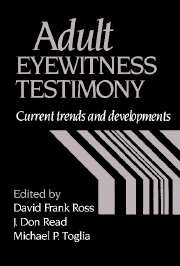Book contents
- Frontmatter
- Contents
- List of contributors
- Preface
- Part I Cognitive, physical and social processes and factors influencing eyewitness recall and identification
- Part II Lineup construction and collection of testimony
- Part III Whom to believe? Distinguishing accurate from inaccurate eyewitnesses
- 13 Distinguishing accurate from inaccurate eyewitness identifications: A reality monitoring approach
- 14 Decision times and eyewitness identification accuracy in simultaneous and sequential lineups
- 15 Individual differences in personality and eyewitness identification
- 16 Eyewitness identification confidence
- 17 Expectations of eyewitness performance: Jurors' verdicts do not follow from their beliefs
- 18 The appraisal of eyewitness testimony
- Name index
- Subject index
16 - Eyewitness identification confidence
Published online by Cambridge University Press: 04 August 2010
- Frontmatter
- Contents
- List of contributors
- Preface
- Part I Cognitive, physical and social processes and factors influencing eyewitness recall and identification
- Part II Lineup construction and collection of testimony
- Part III Whom to believe? Distinguishing accurate from inaccurate eyewitnesses
- 13 Distinguishing accurate from inaccurate eyewitness identifications: A reality monitoring approach
- 14 Decision times and eyewitness identification accuracy in simultaneous and sequential lineups
- 15 Individual differences in personality and eyewitness identification
- 16 Eyewitness identification confidence
- 17 Expectations of eyewitness performance: Jurors' verdicts do not follow from their beliefs
- 18 The appraisal of eyewitness testimony
- Name index
- Subject index
Summary
The production has been staged many times over the last decade. Although the plot and cast of characters have often varied, the story always involves a crime, a number of unsuspecting eyewitnesses, and an attempt to identify the criminal. Despite these variations, the ending usually remains the same: Some eyewitnesses feel certain they have identified the perpetrator; others lack that certainty. The accuracy of a witness's testimony cannot, however, necessarily be garnered from the certainty he or she expresses. Eyewitness confidence has been found to account for less than 10 percent of the variance in eyewitness identification accuracy (Wells & Murray, 1984).
Eyewitness confidence and eyewitness accuracy are often poorly calibrated (for example, Bothwell, Deffenbacher, & Brigham, 1987; Deffenbacher, 1980; Leippe, 1980; Wells & Murray, 1983, 1984). However, jurors tend to rely heavily on eyewitness confidence to infer witness accuracy (for example, Cutler, Penrod, & Stuve, 1988; Lindsay, Wells, & Rumpel, 1981; Wells, Lindsay, & Ferguson, 1979). For example, Wells, Lindsay, and Ferguson found that subject-jurors’ ascriptions of eyewitness confidence accounted for 50 percent of the variance in their assessments of eyewitness accuracy. Furthermore, the United States judiciary recognizes confidence as a key factor to be considered in deciding the accuracy of eyewitness testimony (Neil v. Biggers, 1972). Given the persuasive power that eyewitness confidence can have in the criminal justice system, it is important to understand the factors that influence eyewitness confidence, particularly those factors that can weaken or destroy an existing confidence-accuracy relationship.
- Type
- Chapter
- Information
- Adult Eyewitness TestimonyCurrent Trends and Developments, pp. 348 - 361Publisher: Cambridge University PressPrint publication year: 1994
- 19
- Cited by



